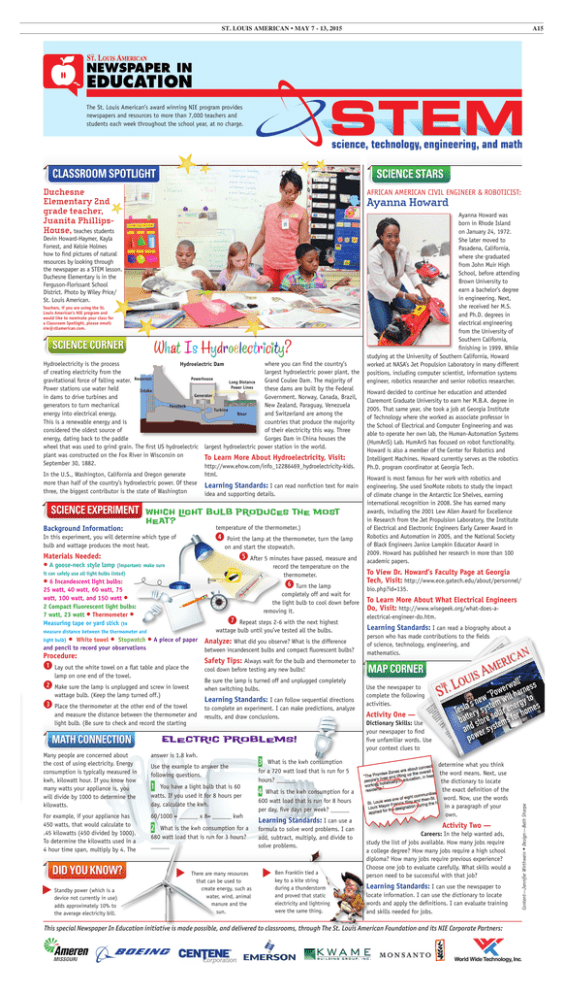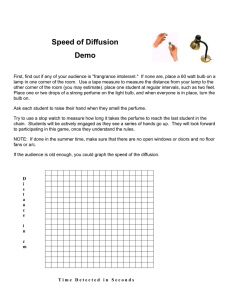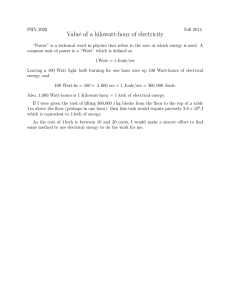What Is Hydroelectricity?
advertisement

A15 ST. LOUIS AMERICAN • MAY 7 - 13, 2015 The St. Louis American’s award winning NIE program provides newspapers and resources to more than 7,000 teachers and students each week throughout the school year, at no charge. CLASSROOM SPOTLIGHT SCIENCE STARS Duchesne Elementary 2nd grade teacher, Juanita PhillipsHouse, teaches students AFRICAN AMERICAN CIVIL ENGINEER & ROBOTICIST: Ayanna Howard Teachers, if you are using the St. Louis American’s NIE program and would like to nominate your class for a Classroom Spotlight, please email: nie@stlamerican.com. What Is Hydroelectricity? SCIENCE CORNER where you can find the country’s Hydroelectricity is the process largest hydroelectric power plant, the of creating electricity from the Grand Coulee Dam. The majority of gravitational force of falling water. these dams are built by the Federal Power stations use water held Government. Norway, Canada, Brazil, in dams to drive turbines and New Zealand, Paraguay, Venezuela generators to turn mechanical and Switzerland are among the energy into electrical energy. countries that produce the majority This is a renewable energy and is of their electricity this way. Three considered the oldest source of Gorges Dam in China houses the energy, dating back to the paddle wheel that was used to grind grain. The first US hydroelectric largest hydroelectric power station in the world. plant was constructed on the Fox River in Wisconsin on To Learn More About Hydroelectricity, Visit: September 30, 1882. http://www.ehow.com/info_12286469_hydroelectricity-kids. In the U.S., Washington, California and Oregon generate html. more than half of the country’s hydroelectric power. Of these Learning Standards: I can read nonfiction text for main three, the biggest contributor is the state of Washington idea and supporting details. SCIENCE EXPERIMENT Background Information: Which Light Bulb Produces the Most Heat? temperature of the thermometer.) r Point the lamp at the thermometer, turn the lamp In this experiment, you will determine which type of bulb and wattage produces the most heat. on and start the stopwatch. t After 5 minutes have passed, measure and Materials Needed: • A goose-neck style lamp (important: make sure record the temperature on the thermometer. it can safely use all light bulbs listed) • 6 Incandescent light bulbs: 25 watt, 40 watt, 60 watt, 75 watt, 100 watt, and 150 watt • 2 Compact Fluorescent light bulbs: 7 watt, 23 watt • Thermometer • Measuring tape or yard stick (to y Turn the lamp completely off and wait for the light bulb to cool down before removing it. u Repeat steps 2-6 with the next highest measure distance between the thermometer and White towel • Stopwatch • A piece of paper and pencil to record your observations light bulb) • Procedure: Analyze: What did you observe? What is the difference between incandescent bulbs and compact fluorescent bulbs? Safety Tips: Always wait for the bulb and thermometer to q Lay out the white towel on a flat table and place the cool down before testing any new bulbs! lamp on one end of the towel. Be sure the lamp is turned off and unplugged completely when switching bulbs. w Make sure the lamp is unplugged and screw in lowest wattage bulb. (Keep the lamp turned off.) Learning Standards: I can follow sequential directions e Place the thermometer at the other end of the towel and measure the distance between the thermometer and light bulb. (Be sure to check and record the starting MATH CONNECTION wattage bulb until you’ve tested all the bulbs. to complete an experiment. I can make predictions, analyze results, and draw conclusions. Electric Problems! Many people are concerned about the cost of using electricity. Energy consumption is typically measured in kwh, kilowatt hour. If you know how many watts your appliance is, you will divide by 1000 to determine the kilowatts. answer is 1.8 kwh. For example, if your appliance has 450 watts, that would calculate to .45 kilowatts (450 divided by 1000). To determine the kilowatts used in a 4 hour time span, multiply by 4. The 60/1000 = ______ x 8= ______ kwh DID YOU KNOW? Standby power (which is a device not currently in use) adds approximately 10% to the average electricity bill. Use the example to answer the following questions. z You have a light bulb that is 60 watts. If you used it for 8 hours per day, calculate the kwh. x What is the kwh consumption for a 680 watt load that is run for 3 hours? ______ There are many resources that can be used to create energy, such as water, wind, animal manure and the sun. is the kwh consumption cfor aWhat 720 watt load that is run for 5 hours? ______ is the kwh consumption for a v600What watt load that is run for 8 hours per day, five days per week? ______ Learning Standards: I can use a formula to solve word problems. I can add, subtract, multiply, and divide to solve problems. Ben Franklin tied a key to a kite string during a thunderstorm and proved that static electricity and lightning were the same thing. Howard decided to continue her education and attended Claremont Graduate University to earn her M.B.A. degree in 2005. That same year, she took a job at Georgia Institute of Technology where she worked as associate professor in the School of Electrical and Computer Engineering and was able to operate her own lab, the Human-Automation Systems (HumAnS) Lab. HumAnS has focused on robot functionality. Howard is also a member of the Center for Robotics and Intelligent Machines. Howard currently serves as the robotics Ph.D. program coordinator at Georgia Tech. Howard is most famous for her work with robotics and engineering. She used SnoMote robots to study the impact of climate change in the Antarctic Ice Shelves, earning international recognition in 2008. She has earned many awards, including the 2001 Lew Allen Award for Excellence in Research from the Jet Propulsion Laboratory, the Institute of Electrical and Electronic Engineers Early Career Award in Robotics and Automation in 2005, and the National Society of Black Engineers Janice Lampkin Educator Award in 2009. Howard has published her research in more than 100 academic papers. To View Dr. Howard’s Faculty Page at Georgia Tech, Visit: http://www.ece.gatech.edu/about/personnel/ bio.php?id=135. To Learn More About What Electrical Engineers Do, Visit: http://www.wisegeek.org/what-does-aelectrical-engineer-do.htm. Learning Standards: I can read a biography about a person who has made contributions to the fields of science, technology, engineering, and mathematics. MAP CORNER Use the newspaper to complete the following activities. Activity One — Dictionary Skills: Use your newspaper to find five unfamiliar words. Use your context clues to determine what you think the word means. Next, use the dictionary to locate the exact definition of the word. Now, use the words in a paragraph of your own. Activity Two — Careers: In the help wanted ads, study the list of jobs available. How many jobs require a college degree? How many jobs require a high school diploma? How many jobs require previous experience? Choose one job to evaluate carefully. What skills would a person need to be successful with that job? Learning Standards: I can use the newspaper to locate information. I can use the dictionary to locate words and apply the definitions. I can evaluate training and skills needed for jobs. This special Newspaper In Education initiative is made possible, and delivered to classrooms, through The St. Louis American Foundation and its NIE Corporate Partners: Content—Jennifer Wirthwein • Design—Beth Sharpe Devin Howard-Haymer, Kayla Forrest, and Kelsie Holmes how to find pictures of natural resources by looking through the newspaper as a STEM lesson. Duchesne Elementary is in the Ferguson-Florissant School District. Photo by Wiley Price/ St. Louis American. Ayanna Howard was born in Rhode Island on January 24, 1972. She later moved to Pasadena, California, where she graduated from John Muir High School, before attending Brown University to earn a bachelor’s degree in engineering. Next, she received her M.S. and Ph.D. degrees in electrical engineering from the University of Southern California, finishing in 1999. While studying at the University of Southern California, Howard worked at NASA’s Jet Propulsion Laboratory in many different positions, including computer scientist, information systems engineer, robotics researcher and senior robotics researcher.

